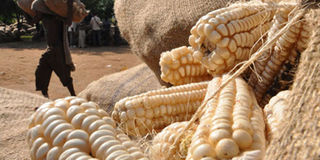New technology to clean aflatoxins from grains

A new technology that cleans aflatoxins from grains has been introduced. FILE PHOTO
What you need to know:
The new technology named Toxin Scrub is expected to turn around Uganda’s loss worth Ss140b into profit and boost exports, Dorothy Nakaweesi writes.
Uganda loses more than $38 million (Shs140b) as a result of failure to export grains due to aflatoxins.
In 2013 alone, more than 600,000 tons of maize worth Shs10b destined for neighbouring Kenya was rejected because they contained traces of aflatoxin.
To solve this challenge, a new technology that cleans aflatoxins from grains has been introduced. This is expected to boost exports and reduce cancer contamination.
This new technology that neutralises mycotoxins in grains called the Toxin Scrub.
Mr Gerald Masila, executive director Eastern Africa Grain Council (EAGC), said: “Africa loses an estimated $670 million (Shs2.4 trillion) in rejected export trade annually due to contamination by aflatoxins.”
Ideally, aflatoxins are poisonous carcinogens that are produced by certain molds which grow in soil, decaying vegetation and grain.
These toxins are regularly found in improperly stored staple commodities grains such as sorghum which consumed as food and used in low cost beer production, maize and groundnuts which are major staple foods consumed by Ugandans and the region.
Also in cassava, chili peppers, cotton seed, millet, rice, sesame seeds, sunflower seeds, wheat, and a variety of spices.
Makerere University senior nutritionist Prof Achileo Kaaya giving an overview of the danger aflatoxins said: “Over 45 per cent of grain in Uganda is infested with aflatoxins and this is a danger to the health of the people.”
Technology
Breaking down how the new toxin scrub technology works, Mr Martin Meldgaard, the managing director of Grain and Toxins – the company behind the innovation, said: “During the processing the material (grain) is exposed to ozone. This is done in a special and efficient way. Ozone is a strong oxidizer that eliminates almost all mycotoxins.”
This makes it convenient for users to simply dump the contaminated material in the inlet and receive decontaminated material in the outlet buffer bin.
Cost
Despite the introduction of the new innovation, farmers may not access it because of its high cost.
“Costs are very high. This makes it impossible for many people to afford and verify its existence,” Mr Masila expressed his concern.
Currently, to be able to clean every tonne of grain, it takes Shs120,000.
He said because of this, the region is not only exposed to health hazards but also revenue loss.
He expressed optimism saying if financiers come on board at the initial stage, it will save the dangers caused by aflatoxins.
Beyond this at the business level, those who are trading in grains maize, sorghum or groundnuts, there is a challenge in the sampling, testing and accessing the labs.
“Will you incur more costs to test while your neighbouring competitor is not doing so? This means your profitability will be damaged,” he explained.
Uganda loses more than $38 million (Shs140b) as a result of failure to export grains due to aflatoxins.
In 2013 alone, more than 600,000 tons of maize worth Shs10b destined for neighbouring Kenya was rejected because they contained traces of aflatoxin.
To solve this challenge, a new technology that cleans aflatoxins from grains has been introduced. This is expected to boost exports and reduce cancer contamination.
This new technology that neutralises mycotoxins in grains called the Toxin Scrub.
Mr Gerald Masila, executive director Eastern Africa Grain Council (EAGC), said: “Africa loses an estimated $670 million (Shs2.4 trillion) in rejected export trade annually due to contamination by aflatoxins.”
Ideally, aflatoxins are poisonous carcinogens that are produced by certain molds which grow in soil, decaying vegetation and grain.
These toxins are regularly found in improperly stored staple commodities grains such as sorghum which consumed as food and used in low cost beer production, maize and groundnuts which are major staple foods consumed by Ugandans and the region.
Also in cassava, chili peppers, cotton seed, millet, rice, sesame seeds, sunflower seeds, wheat, and a variety of spices.
Makerere University senior nutritionist Prof Achileo Kaaya giving an overview of the danger aflatoxins said: “Over 45 per cent of grain in Uganda is infested with aflatoxins and this is a danger to the health of the people.”
Technology
Breaking down how the new toxin scrub technology works, Mr Martin Meldgaard, the managing director of Grain and Toxins – the company behind the innovation, said: “During the processing the material (grain) is exposed to ozone. This is done in a special and efficient way. Ozone is a strong oxidizer that eliminates almost all mycotoxins.”
This makes it convenient for users to simply dump the contaminated material in the inlet and receive decontaminated material in the outlet buffer bin.




